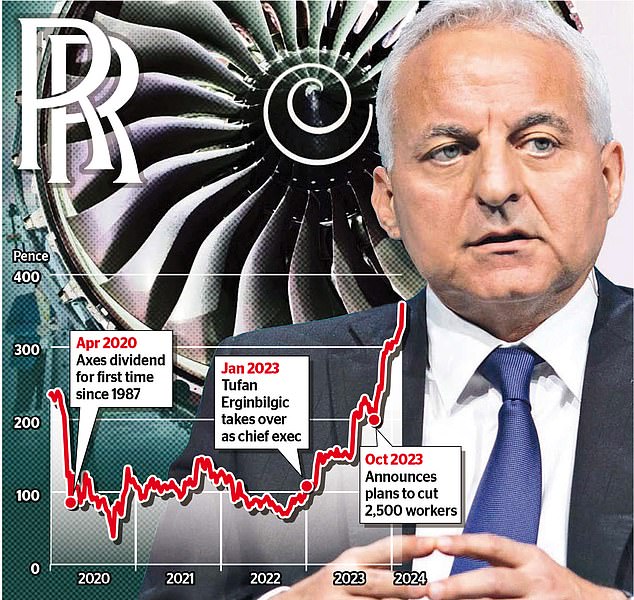<!–
<!–
<!– <!–
<!–
<!–
<!–
Rolls-Royce more than doubled its profits last year as a turnaround led by boss Tufan Erginbilgic bore fruit amid a recovery in air travel.
The engineering giant earned £1.6bn in 2023, up from £652m the previous year, sending its Share price up to 11 percent.
And it has forecast further growth, with profits on track to hit £2bn in 2024.
Profits last year beat analysts’ expectations of £1.4bn, but the company’s investors were left without payouts to shareholders. The British defense company last paid dividends in 2019.
Rolls-Royce explained that it committed to resuming dividends once “the strength of our balance sheet is assured.”

Big boost: Rolls-Royce profits have risen more than 200% since Tufan Erginbilgic (pictured) took over as boss
Julie Palmer, partner at Begbies Traynor, said: “Rolls-Royce investors could be disappointed by the lack of payments to shareholders, despite better performance in 2023.”
Since former BP Erginbilgic executive, who has pledged to quadruple profits by 2027, took over the 118-year-old group in January 2023, shares have soared more than 200 per cent.
They rose 8.3 per cent, or 27.3p, to 356.8p yesterday. Rolls was the biggest riser on the FTSE 100 in 2023, with the stock enjoying its best year since it floated in 1987.
Erginbilgic said: “Our transformation has achieved record performance in 2023, driven by business optimization, cost efficiency and progress on our strategic initiatives.”
Rolls spent years underperforming its previous bosses and was on the brink of bankruptcy during the pandemic.
When Erginbilgic took over last year he described the company as a “burning platform”.
Yesterday it confirmed it had already realized £150m of cost savings of between £400m and £500m outlined in a transformation plan.
Last year it announced plans to cut 2,500 jobs, representing up to 6 percent of its workforce, a move that will primarily affect non-engineering positions.
Rolls aims to make a profit of £2.8bn by 2027 and hopes to boost margins in its core civil aerospace business to 17 per cent.
The company forecast an operating profit of between £1.7bn and £2bn by 2024, but warned supply chain “challenges” would continue for up to two more years.
Erginbilgic also used the results to attack the Government, warning that the first of its mini nuclear reactors could be built in Europe instead of Britain if ministers fail to speed up their decision-making.
He said he was confident the Derby company’s small modular reactor (SMR) technology was still well ahead of its competitors.
But he said time was running out for the UK to benefit from its first-mover advantage, as Rolls has also held talks about rolling out SMR in Eastern Europe.
It comes as Great British Nuclear (GBN), the public body set up to lead the UK’s nuclear power revival, is preparing to choose which SMR prototypes to back from a shortlist of six companies, including Rolls.
After delays in the process, GBN has promised to announce the winners this spring.
But Erginbilgic warned that the selection “would mean nothing” unless detailed decisions are made within months about where the reactors will be built.
Jarek Pominkiewicz, equity analyst at Quilter Cheviot, said: “The impressive results were supported by the company’s transformation program and strategic initiatives, which aimed to improve its business optimization and cost efficiency across the group… the recovery is on the right track.”
The engine maker said revenue rose 21 per cent from £12.7bn to £15.4bn last year.
Sales rose as governments increased their military spending amid heightened global tensions in 2023.
And a recovery in air travel, as demand for vacations soared, helped boost sales and profits.
In its civil aerospace business, large engine flight hours, a key performance measure, recovered to 88 percent of 2019 levels, up from 65 percent in 2022.
Large engine orders hit a 15-year high, with major purchases by Air India and Turkish Airlines.
And the company forecasts that transactions will recover or exceed pre-pandemic levels by the end of 2024.
